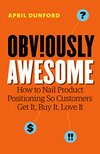Obviously Awesome: How to Nail Product Positioning so Customers Get It, Buy It, Love It
amazon.com
Saved by Rishi and
Obviously Awesome: How to Nail Product Positioning so Customers Get It, Buy It, Love It

Saved by Rishi and
Great positioning takes into account all of the following: The customer’s point of view on the problem you solve and the alternative ways of solving that problem. The ways you are uniquely different from those alternatives and why that’s meaningful for customers. The characteristics of a potential customer that really values what you can uniquely
... See morebut in this context, few people recognize its value.
Competitive alternatives. What customers would do if your solution didn’t exist. Unique attributes. The features and capabilities that you have and the alternatives lack. Value (and proof). The benefit that those features enable for customers. Target market characteristics. The characteristics of a group of buyers that lead them to really care a
... See moreThe customer’s point of view on the problem you solve and the alternative ways of solving that problem. The ways you are uniquely different from those alternatives and why that’s meaningful for customers.
It’s OK to list things here that some folks on the team might think of as negative.
If you had positioned your tuna net as a grouper net in the beginning, you might never have figured out your best positioning. Positioning your net broadly as a “fish net” when you have little market experience is the best way to keep your options open until you have enough customer experience to start seeing patterns.
The common failure in both of these traps is not deliberately positioning the product. We stick with a “default” positioning, even when the product changes or the market changes. I believe this happens because we haven’t been taught that every product can be positioned in multiple ways and often the best position for a product is not the default.
... See moreMarket categories are one way that customers organize products in their minds. Declaring that your product exists in a certain market category will set off a powerful set of assumptions in customers’ minds about who your
These are the Five (Plus One) Components of Effective Positioning: Competitive alternatives. What customers would do if your solution didn’t exist. Unique attributes. The features and capabilities that you have and the alternatives lack. Value (and proof). The benefit that those features enable for customers. Target market characteristics. The
... See more